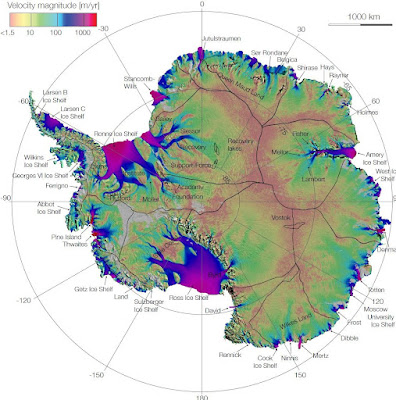Robert Hunziker reports on research into the stability of the Thwaites and Pine Island glaciers. He quotes an article published in The Cryosphere.
Mass loss from the Antarctic Ice Sheet is the main source of uncertainty in projections of future sea-level rise, with important implications for coastal regions worldwide. Central to ongoing and future changes is the marine ice sheet instability: once a critical threshold, or tipping point, is crossed, ice internal dynamics can drive a self-sustaining retreat committing a glacier to irreversible, rapid and substantial ice loss.
Thwaites' "pinning points" are being undermined by warm currents. It's collapse threatens the entire West Antarctic Ice Sheet and could lead to a 3 meter sea level rise.
Update (June 13): A study published in Science Advances finds the breakup of the ice shelf protecting the Pine Island glacier is accelerating.
[Our] data show a >12% speedup over the past 3 years, coincident with a 19-km retreat of the ice shelf. We use an ice-flow model to simulate this loss, finding that accelerated calving can explain the recent speedup, independent of the grounding-line, melt-driven processes responsible for past speedups. If the ice shelf’s rapid retreat continues, it could further destabilize the glacier far sooner than would be expected due to surface- or ocean-melting processes.
Update (December 13): Satellite images presented at the American Geophysical Union meeting show cracks across the ice shelf protecting the Thwaites glacier. The shelf could shatter into hundreds of icebergs within three to five years.
Update (December 17): Robert Hunziker reiterates how precarious the situation is.
Once the ice shelf collapses, it’ll lead to massive "ice cliff collapsing," ongoing collapse of towering walls of ice directly overlooking the ocean that crumbles into the sea. And, once ice cliff collapsing starts, it will likely become a self-sustaining "runaway collapse."
[T]he biggest unknown in this grisly affair is timing, assuming Thwaites does collapse within a decade, how soon will ice cliff collapses bring on sea level rise that drowns the world’s coastal metropolises?
Satellite images from 2015 and 2021:


No comments:
Post a Comment
Note: Only a member of this blog may post a comment.